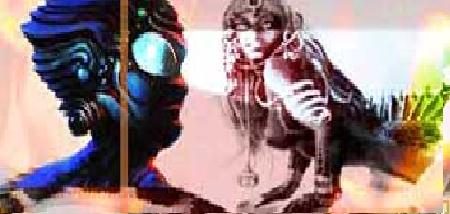BY LETTER
Heteromorphs
Technology > Application > Augmentics
Sophonts > Modosophonts > Biotech Cyborg (Bioborg)
Technology > Technology Type or Material > Organic/Biotech
Sophonts > Modosophonts > Biotech Cyborg (Bioborg)
Technology > Technology Type or Material > Organic/Biotech
 Image from Bernd Helfert |
Heteromorphs are modosophont bionts, usually but not always humans, who have altered their physical form until they are substantially different from their original form.
The term was first applied in the late Information Age to humans who had electively undergone radical surgery to alter or remove parts of their bodies, or to add extra tissue. However, unlike mainstream cosmetic surgery (which was increasingly commonplace at that time) elective heteromorphic surgery was used to sculpt the human body into new and unusual forms. Some heteromorphs had lengthened or shortened limbs or digits, some had artificial horns or antlers implanted, and many had the shape of their heads and other body parts extensively re-engineered.
Heteromorphs often claimed to be exercising their right to 'morphological freedom', a term coined by the early transhumanist Max More in 24 AT. The concept was clarified by Anders Sandberg as 'an extension of one's right to one's body, not just self-ownership but also the right to modify oneself according to one's desires'.
More originally defined the term 'morphological freedom' as 'the ability to alter bodily form at will through technologies such as surgery, genetic engineering, nanotechnology, uploading'. In the Late Information Age surgery was the first of these options to become available, but as nanotechnology, biotechnology and genetic therapy became more advanced, heteromorphs began to take advantage of these too. As is well known, the technology for uploading human mentalities did not come along until much later. The heteromorphy movement was therefore confined at first to bodily modification.
The technology of bioprinting was particularly popular with early heteromorphs. A new or radically redesigned organ or limb could be created and surgically added to the body. These biological heteromorphs were scornful of those who used artificial prosthetics to alter their morphology, and called them 'cyborg wannabes'. By the second century AT 'tweaking' or genetic modification, was increasingly seen as a different route to morphological freedom, and those heteromorphs who used surgery alone began to think of themselves as a separate group from cyborgs and tweaks.
Heteromorphy in the Current Era
Many sophonts in the Current Era change their physical form frequently, into bodymorphs that were completely unattainable in the Interplanetary era. In most cases these transformations are achieved using uploading and subsequent engeneration; an uploaded sophont may be subesquently downloaded into a body of almost any design, while the psychological ramifications of downloading into a radically different body can be handled by 'Body Transformation Protocols', which have been developed for thispurpose over many thousands of uears of refinement.Not all heteromorphs change their form using engeneration; radical changes can also be effected entirely from within the body using bionano, hylonano or synano reshaping, and can happen over a relatively short time period, or (if the sunbject prefers) over an arbitrarily extended period.
A nearbaseline human can choose to be reshaped using such methods into almost any conceivable form, with the proviso that the form has adequate capacity to hold the individual's human brain (which most heteromorphs avoid changing except where necessary to control their new body). On the other hand, members of many non-human clades choose to alter their physical appearance into human form, or into that of other species, or into entirely novel forms.
The cells of a heteromorph who has been radically re-sculpted are generally not changed genetically, unless the subject desires such a change. Germline cells are unaffected, and for this reason most 'exotic' heteromorphy is not inheritable.
Even the most exotic heteromorph can elect to revert back to eir original form, and some exotics change their bodily form many times over the course of their lives. Sophonts who repeatedly change their bodily form are known as rheomorphs, on the other hand those that rarely or never change their form are known as menomorphs. Most modosophonts in the Current Era are somewhere in between these two extremes.
Some exotics have a detachable head or sub-body which they can attach to another larger body at will; such exotics are sometimes called 'doublers' or 'headers'. The secondary bodies must of course be maintained in a healthy state while not in use.
Related Articles
- Automorphism
- Body Transformation Protocols
- Fiarro Twin Worlds, The
- Moodomorphic
- Morphodynamics
- Morphological Freedom
- Morphology - Text by M. Alan Kazlev
The shape of something, especially the organic form of a living being. Also, the study of how morphology is regulated in complex systems such as developing tissues or nanosystems. - Morphotype
- Transbiomorphosis - Text by Adaptecd from Max More, in Anders Sandberg's Transhuman Terminology
[1] (Interplanetary Age, First Federation, Terragen Federation): The transformation of the human body from a natural, biological organism into a superior, consciously designed vehicle of personality.
[2] Genetekkers, Genen, Zoeific Biopolity, TRHN - dramatic modification of one's biological form, not necessarily into a superior (although sometimes that) but just a different form, as a lifestyle choice or artistic expression.
Appears in Topics
Development Notes
Text by Steve Bowers
Initially published on 13 July 2010.
Initially published on 13 July 2010.
Additional Information
Amended March 2025 by Steve Bowers






